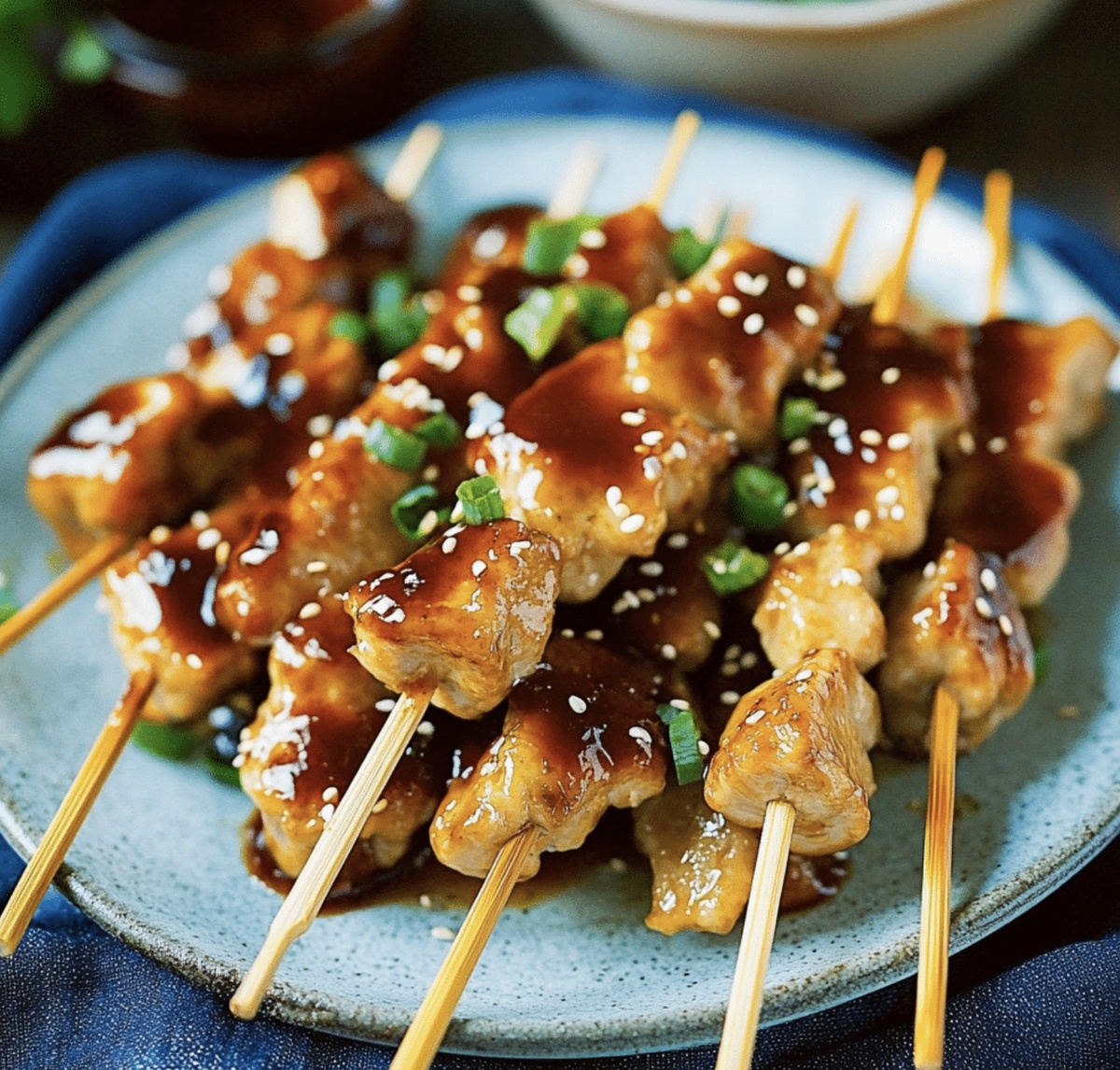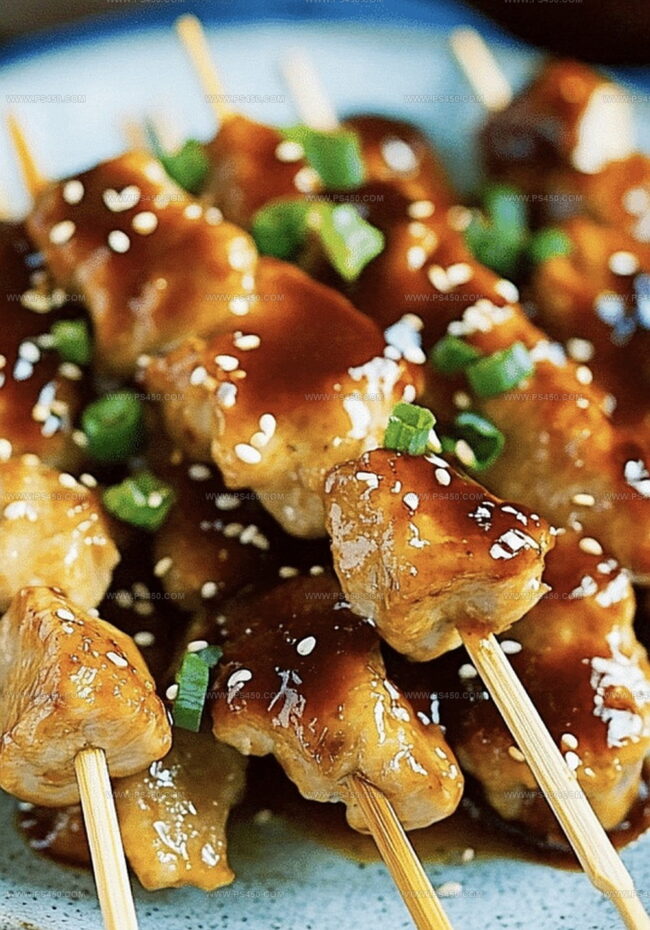Japanese Yakitori Recipe for Skewered Chicken Fans
Crispy chicken skewers in a yakitori recipe can transport you straight to the bustling streets of tokyo.
The aroma of grilled meat sizzling over charcoal might instantly spark memories of vibrant night markets.
Tender bite-sized pieces threaded carefully onto wooden sticks create a delightful canvas for complex marinades.
Japanese home cooks have perfected this simple yet magnificent technique through generations of culinary passion.
Each skewer promises a perfect balance between smoky char and delicate seasoning that dances across your palate.
Marinades infused with soy, mirin, and sake transform ordinary chicken into an extraordinary culinary experience.
Grab some skewers and prepare for a mouthwatering journey that will make you feel like a street food master in your own kitchen.
Why Yakitori Recipe Is Always A Hit
Ingredients For Yakitori Recipe
Protein:Sauce Ingredients:Aromatics:Cooking Accessories:How To Make Yakitori Recipe At Home
Step 1: Brew Flavor-Packed Tare Sauce
Pour all ingredients into a small saucepan and bring to a rolling boil. Reduce heat and let the sauce simmer gently, allowing flavors to meld and transform. Stir occasionally, watching the liquid reduce and thicken into a glossy, rich glaze. After 10-15 minutes, strain out the aromatic garlic and ginger pieces. Set the sauce aside to cool and develop deeper flavors.
Step 2: Prepare Savory Skewer Components
Slice chicken into uniform bite-sized chunks. Chop green onions into short segments. Carefully thread chicken and green onion pieces alternately onto pre-soaked bamboo skewers, creating beautiful striped patterns of protein and vegetable.
Step 3: Fire Up the Grill
Preheat your grill or grill pan to medium heat. Lightly brush grates with oil to prevent sticking. Gently place skewers onto the hot surface, listening for that satisfying sizzle. Cook each side for 3-4 minutes, rotating to ensure even cooking.
Step 4: Glaze and Caramelize
During the final grilling moments, generously brush skewers with the prepared tare sauce. Turn skewers to coat completely, allowing the sauce to caramelize and create a stunning, glossy exterior. Continue grilling for an additional 1-2 minutes until chicken appears golden and slightly charred.
Step 5: Serve and Enjoy
Transfer hot skewers to a serving plate. Drizzle with extra tare sauce if desired. Pair with steamed white rice or serve as a delectable appetizer. These yakitori skewers promise to transport your taste buds straight to the vibrant street markets of Japan.
Smart Tips For Yakitori Recipe
How To Store Yakitori Recipe Properly
What To Eat With Yakitori Recipe
Yakitori Recipe Variations To Try
Yakitori Recipe FAQ List
Yakitori is a popular Japanese street food consisting of grilled chicken skewers typically seasoned with a sweet and savory soy-based sauce called tare. It’s a classic Japanese dish that originated in street food culture and is now enjoyed worldwide.
While traditional Yakitori focuses on chicken, modern variations can include different proteins. However, authentic Japanese Yakitori primarily uses chicken, with various parts of the chicken like thigh meat, breast, and even organ meats being commonly used.
Absolutely! You can use a grill pan, broiler, or even a cast-iron skillet to achieve similar results. The key is to cook the skewers over high heat to get that signature charred and caramelized exterior.
The tare sauce is crucial because it provides a rich, sweet-savory flavor that caramelizes on the chicken, creating a glossy, umami-packed coating that’s signature to authentic Yakitori. It transforms simple grilled chicken into a delicious Japanese delicacy.
Print
Yakitori Recipe
- Total Time: 35 minutes
- Yield: 4 1x
Description
Grilled Japanese Yakitori skewers bring sizzling street food magic straight from Tokyo’s bustling alleys. Juicy chicken pieces marinated in sweet-savory sauce promise an authentic culinary journey that sparks excitement for home cooks seeking delicious international flavors.
Ingredients
Main Protein:
- 1 lb (0.45 kg) boneless, skinless chicken thighs, cut into bite-sized pieces
Aromatics and Flavoring Ingredients:
- 2 garlic cloves, minced
- 1-inch piece of ginger, sliced
- 4–6 green onions (scallions), cut into 2-inch pieces
Liquid and Seasoning Ingredients:
- ½ cup (120 ml) soy sauce
- ½ cup (120 ml) mirin
- ¼ cup (60 ml) sake
- 2 tablespoons (30 ml) sugar
Additional Items:
- Bamboo skewers (soaked in water for 30 minutes)
Instructions
- Craft the tare sauce by combining soy sauce, mirin, sake, sugar, garlic, and ginger in a small saucepan, bringing the mixture to a vigorous boil over medium heat.
- Reduce heat and allow the sauce to simmer, stirring periodically, until the liquid reduces and develops a slightly syrupy consistency, approximately 10-12 minutes.
- Remove the sauce from heat, strain to eliminate garlic and ginger fragments, and let it cool to room temperature while preparing the chicken.
- Select fresh chicken thighs or breast meat, trimming excess fat and cutting into uniform, bite-sized cubes to ensure even cooking.
- Soak wooden skewers in water for 30 minutes to prevent burning during grilling, then carefully thread chicken pieces onto the skewers, interspersing with fresh green onion segments.
- Heat a grill or grill pan to medium-high temperature, lightly coating the surface with oil to prevent sticking and ensure smooth release of skewers.
- Position the chicken skewers on the heated surface, cooking for 3-4 minutes on each side until the meat develops a golden-brown exterior and shows initial signs of caramelization.
- During the final grilling moments, generously brush the skewers with prepared tare sauce, rotating to achieve an even, glossy coating that enhances flavor and color.
- Continue grilling for an additional 1-2 minutes, allowing the sauce to caramelize and create a rich, glazed finish without burning.
- Transfer the yakitori to a serving platter, drizzling with extra tare sauce and garnishing with finely chopped green onions for added freshness and visual appeal.
Notes
- Choose high-quality chicken thighs for maximum flavor and juiciness, ensuring tender and succulent yakitori.
- Soak bamboo skewers in water for at least 30 minutes to prevent burning during grilling, protecting your delicious skewers from charring.
- Experiment with different protein options like tofu, shrimp, or vegetables for vegetarian or diverse dietary preferences, creating versatile skewer variations.
- Control heat carefully while grilling to achieve perfect caramelization without burning the meat, maintaining a beautiful golden-brown exterior and moist interior.
- Prep Time: 15 minutes
- Cook Time: 20 minutes
- Category: Dinner, Appetizer, Snacks
- Method: Grilling
- Cuisine: Japanese
Nutrition
- Serving Size: 4
- Calories: 220
- Sugar: 2 g
- Sodium: 900 mg
- Fat: 10 g
- Saturated Fat: 3 g
- Unsaturated Fat: 4 g
- Trans Fat: 0 g
- Carbohydrates: 12 g
- Fiber: 1 g
- Protein: 26 g
- Cholesterol: 90 mg




Emily Morgan
Food Critic & Kitchen Tips Specialist
Expertise
Global Food Exploration & Critique, Simple Kitchen Hacks & Time-Saving Tips, Presentation & Plating Techniques, Culinary Research & Storytelling.
Education
New York University
Emily Morgan has journeyed across the globe, collecting culinary secrets that turn everyday ingredients into impressive meals.
Based in Seattle and armed with a Journalism degree from NYU, she blends thorough research with a flair for presentation, ensuring every dish looks just as good as it tastes.
Focusing on fresh flavors, simple methods, and a bit of fun, Emily shows home cooks how to elevate their daily cooking without fancy gadgets or complex steps.